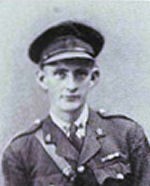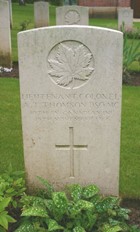The advance is beginning planned, and Major Alexander Thomson is offered a position behind the lines, helping to stage the final advance. “Alex” has certainly earned the chance to get away from battle. He had been at the front since the earliest days of the war. He had been injured twice. He had been awarded two medals, and had risen in this time from foot soldier to an officer in command of other foot soldiers, so he had the experience necessary for a tactical position.
I’d like to think that if I was in Alex’s boots – soaked to the ankle in mud from over two years in the trenches – I’d choose to stay at the front with my men, but if I’m being honest to myself, I think I’d have taken the posting behind the lines.
But Alex didn’t choose the safe way. He may have been a man in command of privates and corporals by 1917, but Major Thomson was a foot soldier at heart. He felt he could best command his men by being with them now that the battle was going to get rough. Such dedication to his battalion drew the attention of Canada’s top soldier, Arthur Currie. During a brief calm later in 1917, General Currie took the time to meet Alex, and to introduce Major Thomson to General Henri Philippe Pétain, who commanded France’s army during the last days of WWI. (Pétain would become France’s president during WWII). After hearing Currie speak so highly of Alex’s bravery, Pétain awarded Alex a third medal – this time the illustrious Croix de Guerre. Then Alex was promoted to lieutenant colonel.
1917, but Major Thomson was a foot soldier at heart. He felt he could best command his men by being with them now that the battle was going to get rough. Such dedication to his battalion drew the attention of Canada’s top soldier, Arthur Currie. During a brief calm later in 1917, General Currie took the time to meet Alex, and to introduce Major Thomson to General Henri Philippe Pétain, who commanded France’s army during the last days of WWI. (Pétain would become France’s president during WWII). After hearing Currie speak so highly of Alex’s bravery, Pétain awarded Alex a third medal – this time the illustrious Croix de Guerre. Then Alex was promoted to lieutenant colonel.
Who is this man who was so respected by the top soldiers of Canada and France? What made him so special?
Well, for one thing, Alex was born and raised in Port Credit. Alex’s father, John Thomson ran a lumber and hardware business located near today’s Go train station. With the announcement of war in August 1914, Alex begged his father not only for a leave of absence from his job, but money for the train ride to the only recruitment camp that was ready to take soldiers as eager as Alex. And so Alex was on his way to Valcartier to be one of Canada’s earliest recruits. After two months of training it was off to the dock at nearby Quebec City for a journey overseas with Canada’s 1st Division.
While serving with the 4th Battalion of the 1st, Lieutenant Thomson was hit in the left shoulder, in April 1915. Following a brief period of recovery behind the lines, in Rouen, France, Alex was moved back to the front in Belgium with the recently-arrived 10th Battalion. Because of his seniority and battle experience, Alex was quickly promoted to captain, but just as he was getting used to the extra “brass” (copper, really) on his shoulders, Alex was again injured in his left shoulder and arm; this time by shrapnel (sharp pieces of broken metal from a shell or grenade) and discharged to England to recuperate. This second injury was worse since it opened the previous wound, and tore out about five inches of flesh, about a half-inch deep, according to a letter sent home to Port Credit.
Remarkably, Alex recovered and returned to the front, to find that his superior officer, Lt. Col J. G. Rattray (who had been injured in the same battle) was still recovering from his wounds and that Alex was to be promoted to Major and placed in command of the 10th until the colonel’s return.
In October 1916, Alex lead his contingent of about 100 men at one of the all-too-many battles near the Somme River. The 10th tried to advance to the river. The enemy struck the 1oth hard in response, and Alex scrambled to get his men to cover, pushing them several hundred metres back to Canadian trenches while he stayed at the rear (closest to the attack) to get his men to safety. For this act of valour, Alex was awarded the Military Cross. It was the second medal for the 27 year old. (He had earned a Distinguished Service honour after his first injury.)
It was at this time that Alex was offered the aforementioned post behind the lines, but Alex chose to stay in the action at the front. It was a brave decision, but it was a decision that cost Alex his life. During an inspection of his troops near the Vimy stronghold, Lt. Col. Alexander T. Thomson was killed by a sniper’s bullet on November 19, 1917. He was 29.
 Like most soldiers killed in action, Alex is not buried in his home town, but instead in a cemetery near the site of the battle which took his life. Alex is buried at Ecoivres Military Cemetery near Mont St-Eloi. The village stands on high ground overlooking the Vimy battlefield.
Like most soldiers killed in action, Alex is not buried in his home town, but instead in a cemetery near the site of the battle which took his life. Alex is buried at Ecoivres Military Cemetery near Mont St-Eloi. The village stands on high ground overlooking the Vimy battlefield.
John and Lillian (née, Blakley) Thomson lost a second son later in the war. Alex’s younger brother, Lieutenant Douglas Cameron Thomson was killed in action with less that two months to go before the armistice. He was 20.
Royal Canadian Legion Branch #82, on Front Street North was honoured as the “Colonel Alex Thomson Memorial Branch” in 1925 at a ceremony that included the unveiling of the current cenotaph on Stavebank Road. The legion was so-named to remind us that one soldier from Port Credit, who had a well-deserved opportunity for comfort behind the battle lines, chose duty to his fellow soldiers instead.
Written by: Richard Collins, Historian
Images:
https://www.veterans.gc.ca/
Portrait of the Thomson brothers. Source: William Perkins Bull. "From Brock to Currie: the military development and exploits of Canadians in general and of the men of Peel in particular, 1791 to 1930." Toronto, 1935.
Photo of Alexander Thomson – Photo from Records of the Fourth Canadian Infantry Battalion in the Great War.
Photo of Alexander Thomson – Photo from Records of the Fourth Canadian Infantry Battalion in the Great War.
Newspaper Clipping – Submitted for the project Operation Picture Me. From the Annie Boyes collection courtesy of the Simcoe County Archives. http://www.simcoe.ca/dpt/arc



 1917, but Major Thomson was a foot soldier at heart. He felt he could best command his men by being with them now that the battle was going to get rough. Such dedication to his battalion drew the attention of Canada’s top soldier, Arthur Currie. During a brief calm later in 1917, General Currie took the time to meet Alex, and to introduce Major Thomson to General Henri Philippe Pétain, who commanded France’s army during the last days of WWI. (Pétain would become France’s president during WWII). After hearing Currie speak so highly of Alex’s bravery, Pétain awarded Alex a third medal – this time the illustrious Croix de Guerre. Then Alex was promoted to lieutenant colonel.
1917, but Major Thomson was a foot soldier at heart. He felt he could best command his men by being with them now that the battle was going to get rough. Such dedication to his battalion drew the attention of Canada’s top soldier, Arthur Currie. During a brief calm later in 1917, General Currie took the time to meet Alex, and to introduce Major Thomson to General Henri Philippe Pétain, who commanded France’s army during the last days of WWI. (Pétain would become France’s president during WWII). After hearing Currie speak so highly of Alex’s bravery, Pétain awarded Alex a third medal – this time the illustrious Croix de Guerre. Then Alex was promoted to lieutenant colonel. Like most soldiers killed in action, Alex is not buried in his home town, but instead in a cemetery near the site of the battle which took his life. Alex is buried at Ecoivres Military Cemetery near Mont St-Eloi. The village stands on high ground overlooking the Vimy battlefield.
Like most soldiers killed in action, Alex is not buried in his home town, but instead in a cemetery near the site of the battle which took his life. Alex is buried at Ecoivres Military Cemetery near Mont St-Eloi. The village stands on high ground overlooking the Vimy battlefield.

